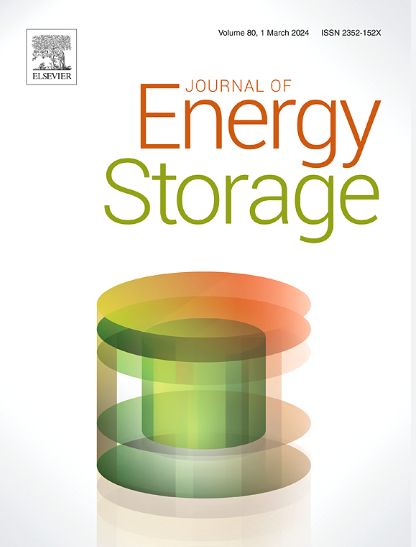热导和形状稳定的聚乙二醇/Cu@rGO-CMF复合相变材料通过三维多孔骨架用于太阳能热能储存和电子冷却
IF 8.9
2区 工程技术
Q1 ENERGY & FUELS
引用次数: 0
摘要
相变材料(PCMs)具有优异的储热性能和稳定的相变温度,在电子设备的可持续热调节方面具有相当大的前景。然而,传统的PCM存在固有的缺陷,如流体泄漏的风险、有限的成型性和低导热性。这些限制严重阻碍了其进一步的技术进步和广泛应用。本文提出了一种简单有效的制备形状稳定、导热性增强的复合相变材料(CPCM)的方法。以碳化三聚氰胺泡沫(CMF)为多孔载体,以还原氧化石墨烯(rGO)为改性材料,采用一步高温还原法结合真空浸渍法制备聚乙二醇(PEG)/Cu@rGO-CMF。实验结果表明,Cu@rGO-CMF构建的三维高密度导热网络显著提高了CPCM的导热系数,提高了87.5%。多孔载体实现了PEG的高效包封(负载比>;97.8%)通过毛细管作用和氢键等物理相互作用,并赋予CPCM优异的形状稳定性和储热性能(149.8-153.2 J/g)。此外,CPCM还具有良好的循环热稳定性、光热转换效率(80.3% - 85.8%)和热管理能力,为先进电子系统中的光伏节能和散热控制提供了简洁有效的解决方案。本文章由计算机程序翻译,如有差异,请以英文原文为准。
Thermally conductive and shape-stable PEG/Cu@rGO-CMF composite phase change material via 3D porous skeleton for solar-thermal energy storage and electronics cooling
Phase change materials (PCMs), possessing exceptional thermal storage properties and exhibiting stable phase change temperatures, hold considerable promise for the sustainable thermal regulation for electronic equipment. However, conventional PCM is associated with inherent drawbacks such as the risk of fluid leakage, limited formability and low thermal conductivity. These limitations have significantly impeded its further technological advancements and widespread applicability. Herein, this paper presents a straightforward and efficient approach for fabricating composite phase change material (CPCM) with shape stability and enhanced thermal conductivity. Polyethylene glycol (PEG)/Cu@rGO-CMF was fabricated via a one-step high-temperature reduction method combined with vacuum impregnation, utilizing carbonized melamine foam (CMF) as the porous carrier and Cu particles with reduced graphene oxide (rGO) as the modified materials. Experimental findings reveal that the three-dimensional high-density thermally conductive network constructed by Cu@rGO-CMF remarkably improves the thermal conductivity of CPCM with a 87.5 % enhancement. The porous carrier achieves efficient encapsulation of PEG (loading ratio > 97.8 %) through physical interactions such as capillary action and hydrogen bonding, and confers excellent shape stability and thermal storage properties (149.8–153.2 J/g) to CPCM. In addition, the CPCM exhibits superior cyclic thermal stability, photothermal conversion efficiency (80.3 %–85.8 %) and thermal management capabilities, thereby offering a concise and effective solution for photovoltaic energy conservation and heat dissipation control in advanced electronics systems.
求助全文
通过发布文献求助,成功后即可免费获取论文全文。
去求助
来源期刊

Journal of energy storage
Energy-Renewable Energy, Sustainability and the Environment
CiteScore
11.80
自引率
24.50%
发文量
2262
审稿时长
69 days
期刊介绍:
Journal of energy storage focusses on all aspects of energy storage, in particular systems integration, electric grid integration, modelling and analysis, novel energy storage technologies, sizing and management strategies, business models for operation of storage systems and energy storage developments worldwide.
 求助内容:
求助内容: 应助结果提醒方式:
应助结果提醒方式:


